
Sofonisba Anguissola, also known as Sophonisba Angussola or Sophonisba Anguisciola, was an Italian Renaissance painter born in Cremona to a relatively poor noble family. She received a well-rounded education that included the fine arts, and her apprenticeship with local painters set a precedent for women to be accepted as students of art. As a young woman, Anguissola traveled to Rome where she was introduced to Michelangelo, who immediately recognized her talent, and to Milan, where she painted the Duke of Alba. The Spanish queen, Elizabeth of Valois, was a keen amateur painter and in 1559 Anguissola was recruited to go to Madrid as her tutor, with the rank of lady-in-waiting. She later became an official court painter to the king, Philip II, and adapted her style to the more formal requirements of official portraits for the Spanish court. After the queen's death, Philip helped arrange an aristocratic marriage for her. She moved to Sicily, and later Pisa and Genoa, where she continued to practice as a leading portrait painter.
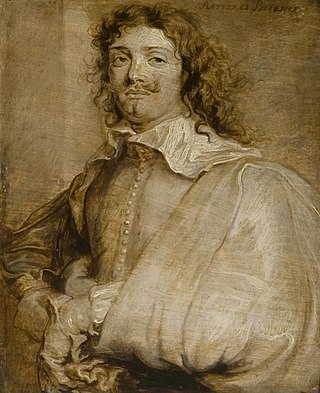
Adriaen Brouwer was a Flemish painter active in Flanders and the Dutch Republic in the first half of the 17th century. Brouwer was an important innovator of genre painting through his vivid depictions of peasants, soldiers and other "lower class" individuals engaged in drinking, smoking, card or dice playing, fighting, music making etc. in taverns or rural settings. Brouwer contributed to the development of the genre of tronies, i.e. head or facial studies, which investigate varieties of expression. In his final year he produced a few landscapes of a tragic intensity. Brouwer's work had an important influence on the next generation of Flemish and Dutch genre painters. Although Brouwer produced only a small body of work, Dutch masters Peter Paul Rubens and Rembrandt collected it.
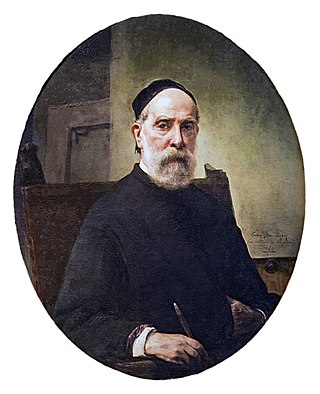
Francesco Hayez was an Italian painter. He is considered one of the leading artists of Romanticism in mid-19th-century Milan, and is renowned for his grand historical paintings, political allegories, and portraits.

Portrait painting is a genre in painting, where the intent is to represent a specific human subject. The term 'portrait painting' can also describe the actual painted portrait. Portraitists may create their work by commission, for public and private persons, or they may be inspired by admiration or affection for the subject. Portraits often serve as important state and family records, as well as remembrances.

Il bacio is an 1859 painting by the Italian artist Francesco Hayez. It is possibly his best-known work. This painting conveys the main features of Italian Romanticism and has come to represent the spirit of the Risorgimento. It was commissioned by Alfonso Maria Visconti di Saliceto, who donated it to the Pinacoteca di Brera after his death.
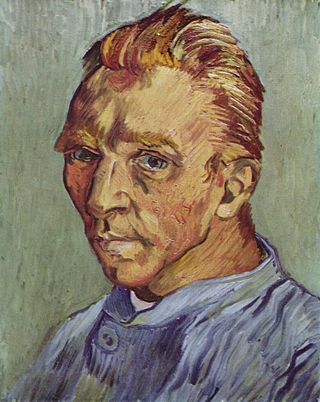
A self-portrait is a portrait of an artist made by themselves. Although self-portraits have been made since the earliest times, it is not until the Early Renaissance in the mid-15th century that artists can be frequently identified depicting themselves as either the main subject, or as important characters in their work. With better and cheaper mirrors, and the advent of the panel portrait, many painters, sculptors and printmakers tried some form of self-portraiture. Portrait of a Man in a Turban by Jan van Eyck of 1433 may well be the earliest known panel self-portrait. He painted a separate portrait of his wife, and he belonged to the social group that had begun to commission portraits, already more common among wealthy Netherlanders than south of the Alps. The genre is venerable, but not until the Renaissance, with increased wealth and interest in the individual as a subject, did it become truly popular.
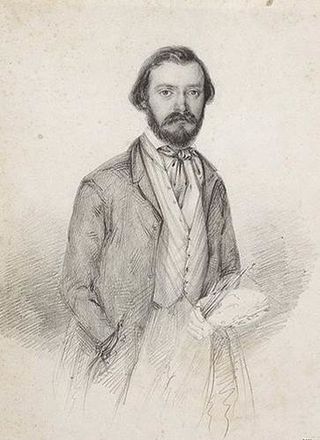
Domenico Induno was an Italian painter, primarily of genre and historical scenes. His younger brother, Gerolamo, also became a well-known artist and they often worked together.
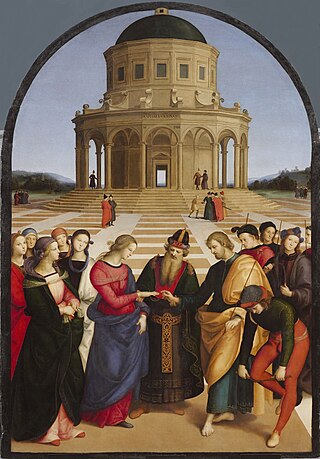
The Marriage of the Virgin, also known as Lo Sposalizio, is an oil painting by the Italian High Renaissance artist Raphael. Completed in 1504 for the Franciscan church of San Francesco, Città di Castello, the painting depicts a marriage ceremony between Mary and Joseph. It changed hands several times before settling in 1806 at the Pinacoteca di Brera.
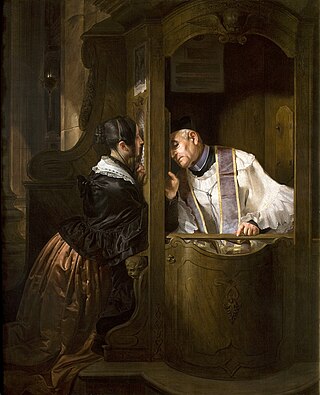
Giuseppe Molteni was an Italian painter.

The art collections of Fondazione Cariplo are a gallery of artworks with a significant historical and artistic value owned by Fondazione Cariplo in Italy. It consists of 767 paintings, 116 sculptures, 51 objects and furnishings dating from the first century AD to the second half of the twentieth.

Cherubino Cornienti was an Italian painter, active in a Romantic style mainly in Northern Italy.
Giovanni Battista Ciolina was an Italian neo-impressionist and divisionist painter.

Self-portrait in a circle of friends in Mantua, also referred to as Self-Portrait in the Circle of Mantuan Friends or, for short, as Mantuan Friendship Picture is an oil painting on canvas by the Flemish artist Peter Paul Rubens, produced between 1602 and 1606 when the artist worked in Mantua as a court painter of the Gonzagas. It is in the collection of the Wallraf-Richartz Museum in Cologne. It is the oldest known self-portrait by Rubens. It falls in a particular genre of portraits which was popular in the 16th and 17th century, the so-called friendship portrait which depicts an informal gathering of friends or companions. It is more specifically a portrait of a circle of Stoic friends or companions.
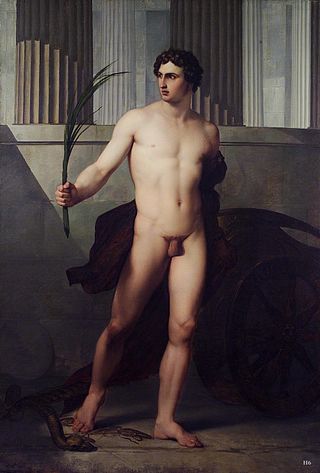
The Victorious Athlete or The Triumphant Athlete is an oil-on-canvas painting by the Italian artist Francesco Hayez, from 1813. It is held in the Accademia di San Luca, in Rome.

Self-Portrait Aged 71 is an 1862 oil-on-canvas painting by the Italian artist Francesco Hayez. The Uffizi had been requesting a self-portrait from him since 1858 via Andrea Appiani's daughter-in-law Giuseppina Appiani Strigelli and it finally arrived in 1863. It is still in the Uffizi's Vasari Corridor.

Lampugnani's Conspiracy is an 1826 oil-on-canvas painting by the Italian artist Francesco Hayez, now in the pinacoteca di Brera in Milan, which acquired it in 1907. It shows the conspiracy led by Giovanni Andrea Lampugnani, Girolamo Olgiati, Carlo Visconti and Cola Montano to overthrow the tyranny of Galeazzo Maria Sforza, killed on 26 December 1476 in Santo Stefano church in Milan.
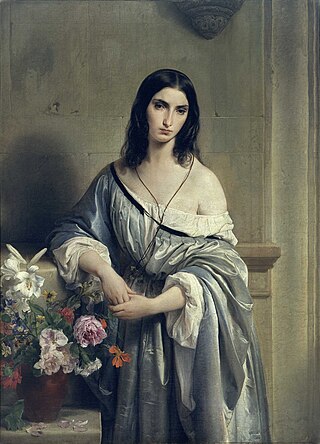
Melancholy is an oil-on-canvas painting executed during 1840–41 by the Italian artist Francesco Hayez, now in the pinacoteca di Brera in Milan.
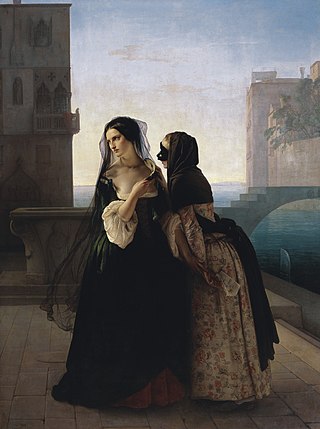
The Revenge Triptych is a set of three mid-19th-century oil-on-canvas paintings by Francesco Hayez. They centre on a woman named Maria and her revenge upon a lover who has betrayed her.

Portrait of Countess Antonietta Negroni Prati Morosini as a Child is an 1858 oil-on-canvas portrait by the Italian artist Francesco Hayez, commissioned by the subject's father Alessandro Negroni Prati Morosini. It is now in the Galleria d'Arte Moderna, in Milan, to which it was given in 1935 by Anna Cristina del Mayno Casati.

Portrait of Alessandro Manzoni is an 1841 oil-on-canvas portrait of Alessandro Manzoni by the Italian painter Francesco Hayez, now in the Pinacoteca di Brera. It was commissioned in 1840 by Manzoni's second wife countess Teresa Borri Stampa and his son Stefano. After fifteen sittings the painter completed the work on 26 June 1841. Eight years later Teresa commissioned a portrait of herself by the same artist.



















